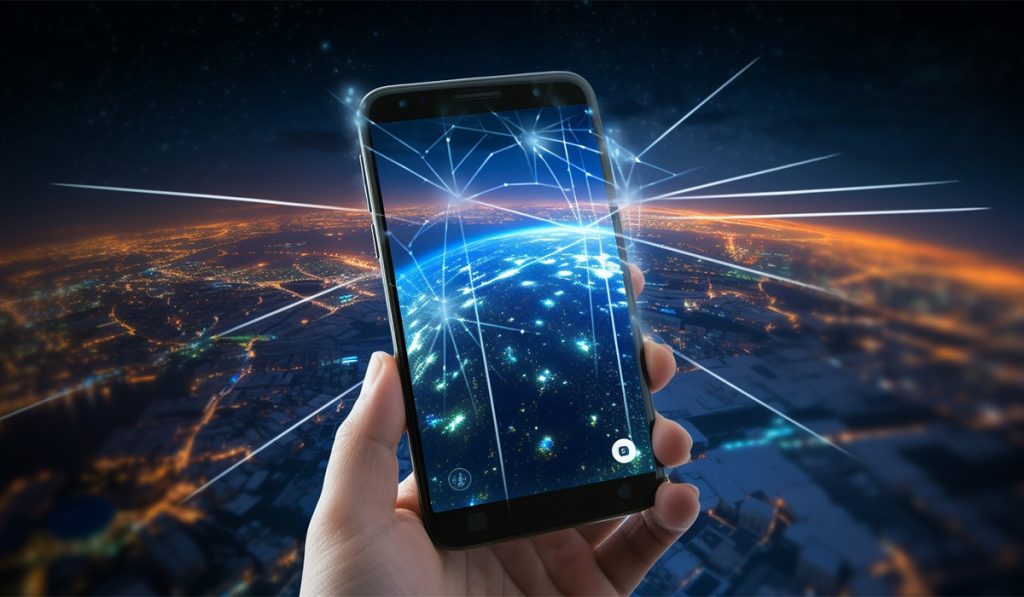Maui, Hawaii – In a groundbreaking achievement, a leading satellite network provider announced on Tuesday that it has successfully conducted a voice and data call from an unmodified smartphone using its space hardware. This remarkable 5G call, the first of its kind, bridged the gap between Maui, Hawaii, and Madrid, Spain, connecting a Vodafone engineer to a wireless dead zone near Hana, Hawaii, using AT&T spectrum and AST SpaceMobile’s cutting-edge BlueWalker 3 test satellite. The call was made on September 8th, utilizing a Samsung Galaxy S22 smartphone.
In addition to this historic 5G call, AST SpaceMobile achieved another significant milestone in a separate test. The company, which is in the process of building a space-based cellular broadband network, recorded a download speed of 14 Mbps, setting a new data session record.
AST CEO Abel Avellan expressed his enthusiasm, stating, “Since the launch of BlueWalker 3, we have achieved full compatibility with phones made by all major manufacturers and support for 2G, 4G LTE, and now 5G. Making the first successful 5G cellular broadband connections from space directly to mobile phones is yet another significant advancement in telecommunications AST SpaceMobile has pioneered.”
AT&T Network President Chris Sambar echoed this sentiment, emphasizing, “These moments are extraordinary milestones in telecommunications history. These first-of-a-kind innovations would not be possible without ecosystem-wide collaboration. We’re all working together to achieve the shared vision of space-based connectivity for consumers, businesses, and first responders all around the globe.”
Expanding Horizons, But Not Without Challenges
While this achievement opens new horizons for 5G technology, experts point out that practical applications for consumers and businesses may remain somewhat distant. Jason Leigh, a senior research analyst for mobility at IDC, a global market and research firm, noted, “The real applications of it, though — whether it’s for consumers or business — remain relatively distant.”
Michael Hodel, director of equity research for the media and telecom sector at Morningstar Research Services in Chicago, concurred, stating, “A small subset of the population that spends a lot of time outside typical network coverage areas might be very interested in having satellite capabilities on their smartphones, eliminating the need for a separate satellite phone.”
However, Hodel added, “I suspect that the average consumer won’t be willing to pay more for satellite access month in and month out, but I could see it periodically appealing to people when traveling in remote areas.”
Willingness to Pay: A Key Challenge
The willingness of consumers to pay for satellite access remains a pivotal question. John Strand of Strand Consult in Denmark, a consulting firm with a focus on telecom, expressed skepticism, saying, “It’s easier to write stories about what you can do with the combination of mobile and satellite than it is to get customers to pay for the extra functionality.”
He highlighted the challenge of competing with the expanding mobile coverage and Wi-Fi options in many places. “The big questions are whether customers are willing to pay extra to be able to use a satellite connection on their mobile phone,” he observed, “and how much a mobile operator is willing to pay for its customers to get access to an additional network.”
A Vision for Enhanced Connectivity
Despite the challenges, Michael Misrahi, Americas telecommunications leader for global professional services firm Ernst & Young, sees a genuine need for 5G satellite service. He emphasized that a fully interoperable terrestrial and non-terrestrial network could provide complete coverage, free from the limitations of traditional towers and terrestrial radio units. Such a network could prove invaluable for maritime, rural, and enterprise applications.
Misrahi stated, “This makes digital transformations and use case adoption for the enterprise in IoT, AI, and elsewhere all technically viable and without disruption by a singular infrastructure fail or potentially by borders.”
Bridging the Connectivity Gap
The primary driving force behind 5G satellite service is addressing the 2.6 billion people globally who lack internet access. Octavio Garcia, a senior analyst with Forrester, emphasized the importance of technology solutions that bridge this gap. However, he also noted that initial use cases for 5G satellite are geared towards emergency calls, messages, and low data transmissions below 75 Mbps.
While 5G satellite technology holds great promise, some limitations remain. Jason Leigh pointed out, “The AST test resulted in a download speed of 14 Mbps — that doesn’t even meet the FCC’s definition of broadband, which starts at 25 Mbps download speeds.” This suggests that satellite connectivity, for now, serves as a last-resort option with limited broad-scale utility.
The Future of Wireless Communication
Despite the challenges and uncertainties, many experts see the future of wireless communication orbiting the Earth. Technology analyst Jeff Kagan predicts that 5G satellite service for voice and data represents the next step in wireless evolution. As satellite and wireless services continue to converge, complete connectivity between smartphones, smartwatches, laptops, and other wireless devices to satellites may become a reality.
The satellite industry is evolving rapidly, driven by innovations like Elon Musk’s Starlink network, which has disrupted the industry by deploying thousands of low-earth satellites. However, challenges related to frequency usage and competition among satellite providers remain.
In conclusion, while the road ahead for 5G satellite service may be challenging, it holds great potential to revolutionize connectivity and bridge the digital divide, ultimately shaping the future of wireless communication.
Source: technewsworld
